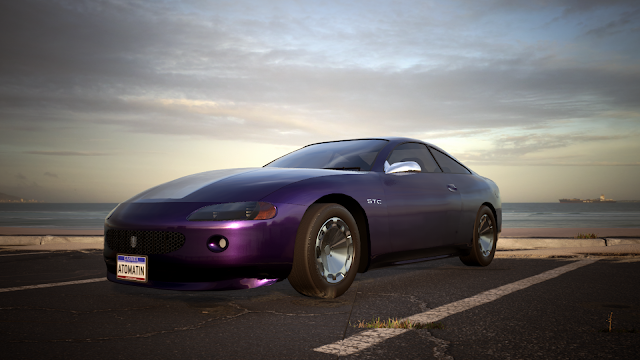Confessions of an Automationeer, Part 185: An Early Holiday Gift
In preparation for the holiday season, I have decided to continue experimenting with various ideas in Automation. One of these was to determine the viability of the '92 Evade body set (in 2-door notchback coupe configuration, with a 2.89m wheelbase) as the basis for a personal luxury coupe. The resulting build was called the SVM Sandtiger - and I had a lot of fun doing it.
Above, from top: The '92 SVM Sandtiger was the result of an experiment to determine whether or not any of the '92 Evade body sets could be used as the basis of a personal luxury coupe. As it turned out, the idea was indeed viable, although I must admit that using the same morphing settings on any size smaller than the largest one (with its 2.89m wheelbase) would distort the proportions too much.
A full-width rear reflector helped emphasize its width, while the flush-fitting headlights and egg-crate lower grille were very much in keeping with the style of the times. There were subtle (but non-functional) front and rear spoilers (simulated using body molding fixtures) As befitting a large, luxurious flagship, a powerful engine (a 300-horsepower 5.7-liter all-alloy overhead-valve V8) came as standard, as did a fully independent suspension (dual wishbones up front and a multilink rear) with air springs and adjustable adaptive dampers. On the LTC trim level (shown above), a 4-speed electronically controlled automatic transmission came as standard, as was a full luxury interior (complete with genuine wood and leather trim, available in multiple with a high-end CD/cassette tape stereo system.
Above, from top: The Sandtiger's interior was very luxurious for its time - despite only being a four-seater, it had rear-seat air vents (something that has become more commonplace in lower-end cars today) as part of its standard equipment list.
The LTC (Luxury Touring Coupe) trim level comprised the bulk of Sandtiger sales, but it wasn't the only one on offer. Alongside it sat the more performance-oriented STC (Sports Touring Coupe), which was aimed at younger buyers. It had the same amount of standard equipment inside and out as the LTC, but had wider, high-performance tires and larger alloy wheels, as well as a slightly stiffer suspension and, crucially, a 6-speed manual transmission as standard (although the LTC's automatic option was available at no extra cost). Apart from different badging and the use of plastic or color-coded (rather than chrome) exterior trim (except on the wing mirrors, which could be finished in chrome as on the LTC), however, there was little else to differentiate the STC from the LTC externally.
Above, from top: The Sandtiger STC (shown here in a rare 6-speed manual spec) was geared towards enthusiasts, but relatively few of them were sold throughout the car's lifespan.
With so little visual differentiation between the two trims, the STC sold relatively poorly during the Sandtiger's production run. However, that rarity has resulted in greater collectability today, especially for examples fitted with the manual gearbox.
In short, the Sandtiger (especially in STC guise) may not have been as much of a commercial success as its maker intended, but it still managed to act as a halo car for the brand, which would learn lessons from its development and production and apply them to the rest of its range. As for any future plans with the Sandtiger, I don't yet have any of those - except for a convertible variant of both trims (which would be heavier and less rigid, but potentially even more attractive), and a facelifted version coming within five or six years of the initial launch.










No comments:
Post a Comment